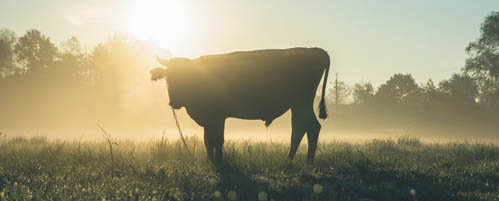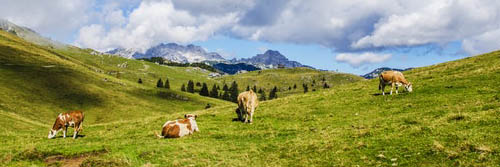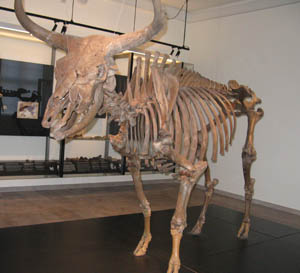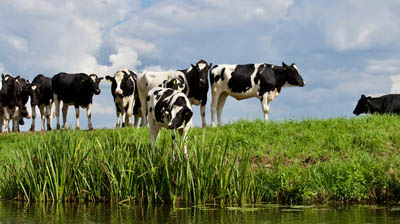 |
||||||
|
||||||
|
|||||||
 |
|||||||
| Cow/Ox |
|||||||
When we speak of a cow today, we usually mean an animal of the species known in latin as Bos Taurus, which can refer to any such four-legged horned creature, including its male individuals such as bull and ox. Of course cow and bull are also general terms for the female or male individuals of other species including Moose, Elephants, Sea Lions and Whales, but here we are talking about the species which is also called bovine or in plural, cattle. Cows have been domesticated by humans some 8000 to 1000 years ago, their wild ancestor was called the Aurochs. The wild Aurochs became extinct in the 1600s, however the designation Ox for a male individual of domestic cattle has survived. Technically the word Ox today refers to a castrated male although it isn't always used with that meaning. |
|||||||
|
|||||||
Typical external characteristics of cows are their split hooves and horns. By nature all cows should have horns, with variations in size, however some races have been bred by humans that no longer have horns, others had their horns removed by humans, which is a very painful operation on the young animal. Another typical characteristic for female cows is the udder with its four teats, the place where we get cow milk from. Another special characteristic of cattle, although they can't be seen, are their massice four-chambered stomachs, which basically work like a bowl in which the food is fermented. Their digestion system is specialized into first filling up the stomach with a lot of grass that has been chewed only a little or not at all, which is then regurgitated later to be re-chewed. The advantage of this digestion is, that cows need to spend little time in the vulnerable position with their head down and may re-chew their food with head raised, while being watchful for approaching predators. The jaws and teeth of the cow are specialized on chewing grass, moving in a typical circular motion (not unlike humans chewing on chewing gum)
|
|||||||
|
|||||||
The herding of cows is an integral part of many cultures, becoming part of the culture, for example in such events as rodeo, but also bullfights and a special kind of human stereotype, the cowboy is a result of this. In the Chinese zodiac, 牛 niú is the second animal of the 12 year cycle. The Chinese character actually can mean cow, bull or ox although in english it is usually referred to as “the year of the ox”. People born in the year of the Ox are considered to be honest and earnest, they do not care about praise or fame, earning recognition from their hard work. They have no problems in following the rules, yet their calm character and logical thinking make them good leaders. |
|||||||
 |
|||||||
Size: height 1.6-1.8m length 2.3-2.6m |
|||||||
| return to top |

